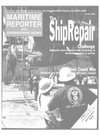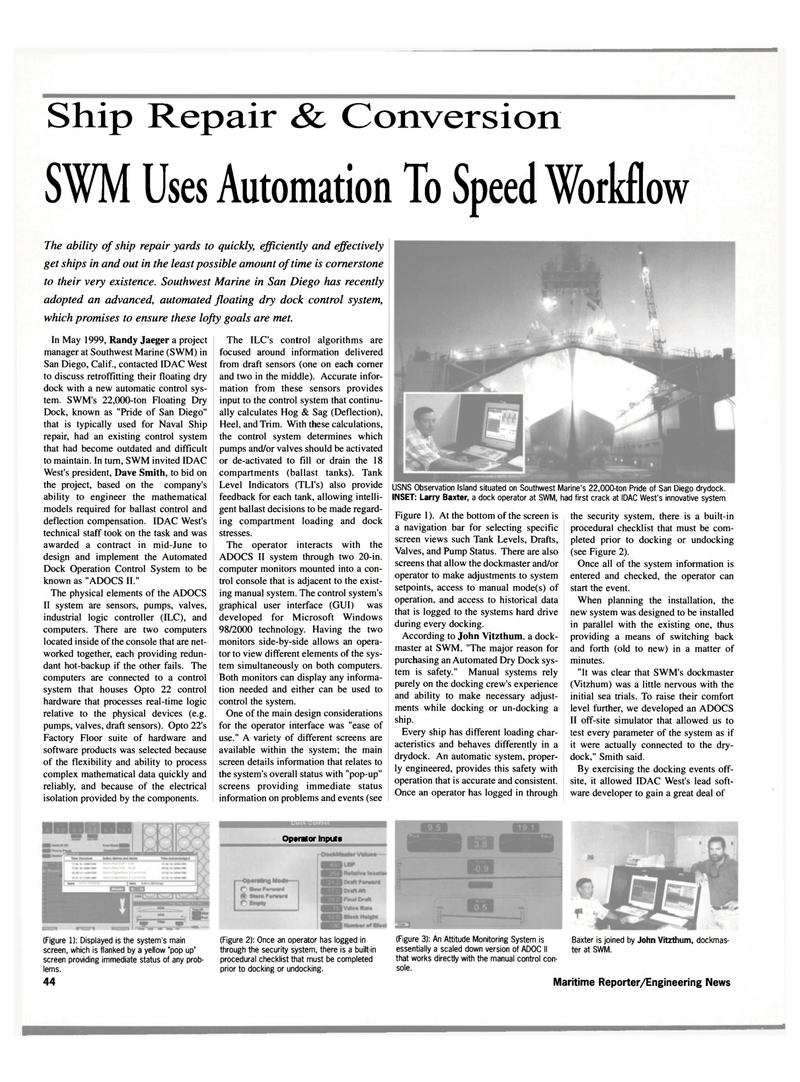
Page 46: of Maritime Reporter Magazine (October 2000)
Read this page in Pdf, Flash or Html5 edition of October 2000 Maritime Reporter Magazine
Ship Repair & Conversion
SWM Uses Automation To Speed Workflow
The ability of ship repair yards to quickly, efficiently and effectively get ships in and out in the least possible amount of time is cornerstone to their very existence. Southwest Marine in San Diego has recently adopted an advanced, automated floating dry dock control system, which promises to ensure these lofty goals are met.
In May 1999, Randy Jaeger a project manager at Southwest Marine (SWM) in
San Diego, Calif., contacted IDAC West to discuss retroffitting their floating dry dock with a new automatic control sys- tem. SWM's 22,000-ton Floating Dry
Dock, known as "Pride of San Diego" that is typically used for Naval Ship repair, had an existing control system that had become outdated and difficult to maintain. In turn, SWM invited IDAC
West's president, Dave Smith, to bid on the project, based on the company's ability to engineer the mathematical models required for ballast control and deflection compensation. IDAC West's technical staff took on the task and was awarded a contract in mid-June to design and implement the Automated
Dock Operation Control System to be known as "ADOCS II."
The physical elements of the ADOCS
II system are sensors, pumps, valves, industrial logic controller (ILC), and computers. There are two computers located inside of the console that are net- worked together, each providing redun- dant hot-backup if the other fails. The computers are connected to a control system that houses Opto 22 control hardware that processes real-time logic relative to the physical devices (e.g. pumps, valves, draft sensors). Opto 22's
Factory Floor suite of hardware and software products was selected because of the flexibility and ability to process complex mathematical data quickly and reliably, and because of the electrical isolation provided by the components.
The ILC's control algorithms are focused around information delivered from draft sensors (one on each corner and two in the middle). Accurate infor- mation from these sensors provides input to the control system that continu- ally calculates Hog & Sag (Deflection),
Heel, and Trim. With these calculations, the control system determines which pumps and/or valves should be activated or de-activated to fill or drain the 18 compartments (ballast tanks). Tank
Level Indicators (TLI's) also provide feedback for each tank, allowing intelli- gent ballast decisions to be made regard- ing compartment loading and dock stresses.
The operator interacts with the
ADOCS II system through two 20-in. computer monitors mounted into a con- trol console that is adjacent to the exist- ing manual system. The control system's graphical user interface (GUI) was developed for Microsoft Windows 98/2000 technology. Having the two monitors side-by-side allows an opera- tor to view different elements of the sys- tem simultaneously on both computers.
Both monitors can display any informa- tion needed and either can be used to control the system.
One of the main design considerations for the operator interface was "ease of use." A variety of different screens are available within the system; the main screen details information that relates to the system's overall status with "pop-up" screens providing immediate status information on problems and events (see
Figure 1). At the bottom of the screen is a navigation bar for selecting specific screen views such Tank Levels, Drafts,
Valves, and Pump Status. There are also screens that allow the dockmaster and/or operator to make adjustments to system setpoints, access to manual mode(s) of operation, and access to historical data that is logged to the systems hard drive during every docking.
According to John Vitzthum, a dock- master at SWM. "The major reason for purchasing an Automated Dry Dock sys- tem is safety." Manual systems rely purely on the docking crew's experience and ability to make necessary adjust- ments while docking or un-docking a ship.
Every ship has different loading char- acteristics and behaves differently in a drydock. An automatic system, proper- ly engineered, provides this safety with operation that is accurate and consistent.
Once an operator has logged in through the security system, there is a built-in procedural checklist that must be com- pleted prior to docking or undocking (see Figure 2).
Once all of the system information is entered and checked, the operator can start the event.
When planning the installation, the new system was designed to be installed in parallel with the existing one, thus providing a means of switching back and forth (old to new) in a matter of minutes. "It was clear that SWM's dockmaster (Vitzhum) was a little nervous with the initial sea trials. To raise their comfort level further, we developed an ADOCS
II off-site simulator that allowed us to test every parameter of the system as if it were actually connected to the dry- dock," Smith said.
By exercising the docking events off- site, it allowed IDAC West's lead soft- ware developer to gain a great deal of
Operator Inputs (Figure 1): Displayed is the system's main screen, which is flanked by a yellow "pop up" screen providing immediate status of any prob- lems. 44 (Figure 2): Once an operator has logged in through the security system, there is a built-in procedural checklist that must be completed prior to docking or undocking. (Figure 3): An Attitude Monitoring System is essentially a scaled down version of ADOC II that works directly with the manual control con- sole.
Baxter is joined by John Vitzthum, dockmas- ter at SWM.
Maritime Reporter/Engineering News
USNS Observation Island situated on Southwest Marine's 22,000-ton Pride of San Diego drydock.
INSET: Larry Baxter, a dock operator at SWM, had first crack at IDAC West's innovative system

 45
45

 47
47
